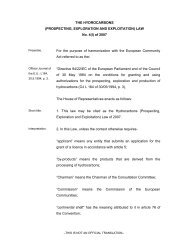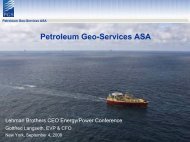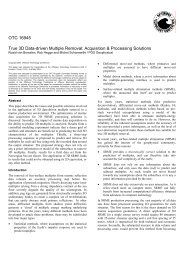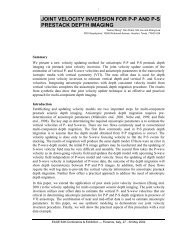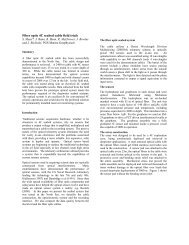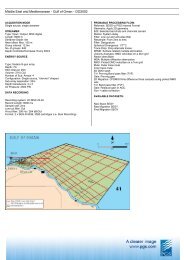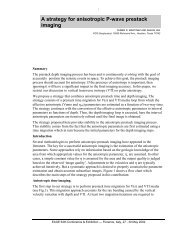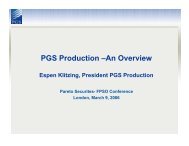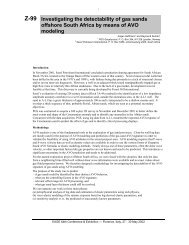Annual Report 2011 - PGS
Annual Report 2011 - PGS
Annual Report 2011 - PGS
You also want an ePaper? Increase the reach of your titles
YUMPU automatically turns print PDFs into web optimized ePapers that Google loves.
Letter from the CEO<br />
GeoStreamer technology. Ramform Viking and<br />
<strong>PGS</strong> Apollo were equipped with GeoStreamer<br />
in <strong>2011</strong> and by year-end nearly 60 percent of our<br />
streamer capacity was GeoStreamer.<br />
Technology Leadership<br />
Technology plays an increasingly important<br />
role in supplier differentiation and building<br />
our competitive advantage. GeoStreamer<br />
is the best example of <strong>PGS</strong>’ technology<br />
differentiation. At its launch in June 2007,<br />
it was heralded as the most significant<br />
breakthrough in streamer technology in 60<br />
years. GeoStreamer is the first-ever dual-sensor<br />
streamer, yielding greater imaging on deeper<br />
targets, enhanced resolution and improved<br />
operational efficiency.<br />
In <strong>2011</strong>, we enhanced GeoStreamer technology<br />
with the introduction of GeoSource (GS).<br />
GeoStreamer in combination with GeoSource<br />
comprise our GeoStreamer GS technology,<br />
the only ghost-free acquisition solution in the<br />
industry. GeoStreamer GS improves bandwidth<br />
beyond the capabilities of the GeoStreamer<br />
and delivers unrivaled image resolution.<br />
GeoStreamer GS is unique in its ability to<br />
generate sharper, more precise imaging of<br />
complex targets located at great depths or<br />
beneath salt, basalt, and other challenging<br />
geological structures. <strong>PGS</strong> aims to equip all<br />
GeoStreamer vessels with GeoStreamer GS<br />
technology by year-end 2012.<br />
Our next products in the technology pipeline<br />
are the OptoSeis fiber-optic solution for<br />
permanent monitoring and towed Electro<br />
Magnetic (towed EM) acquisition. We are<br />
moving ahead with our fiber-optic deployment<br />
breakthrough, the agreement signed with<br />
Petrobras in 2010 for a seabed-installed fiberoptic<br />
monitoring system at the deepwater<br />
Jubarte field offshore Brazil. The system will be<br />
installed mid 2012. We are planning to run the<br />
first commercial towed EM survey in 2012. Our<br />
ultimate goal is to acquire seismic and EM data<br />
simultaneously.<br />
Financial Strength<br />
Building on our strategy of having a<br />
conservative balance sheet, <strong>PGS</strong> has<br />
maintained its ability to invest in technology,<br />
MultiClient library, and capacity expansion<br />
despite a challenging market. We extended the<br />
Company’s debt maturity, from approximately<br />
three years in early <strong>2011</strong> to approximately four<br />
years by year-end. Issuance of a $300 million<br />
Senior Notes due in 2018 and amendment of<br />
our revolving credit facility were the two most<br />
significant achievements. The Senior Notes<br />
offering was well received in the market and<br />
priced at favorable terms.<br />
Our strategy has and will continue to be<br />
to deliver return to shareholders over the<br />
business cycle. To demonstrate the earnings<br />
capability of <strong>PGS</strong> the Board of Directors<br />
propose to the <strong>Annual</strong> General Meeting in 2012<br />
a dividend for the full year <strong>2011</strong> of NOK 1.10 per<br />
share, in line with earlier announcements. We<br />
have a dividend policy aimed at distributing 25-<br />
50 percent of net income to shareholders over<br />
the business cycle.<br />
Health, safety, environment, and quality —<br />
HSEQ — remains a key priority for <strong>PGS</strong>. Our<br />
ambition is to operate in a manner that does<br />
not cause harm to people or the environment.<br />
Total Recordable Case Frequency (TRCF) was<br />
1.44 per million man-hours in <strong>2011</strong> compared<br />
with 1.94 per million man-hours in 2010. The<br />
Lost Time Incident Frequency (LTIF) for <strong>2011</strong><br />
was 0.93 per million man-hours compared with<br />
0.59 per million man-hours in 2010. We work<br />
proactively to reduce employees’ exposure to<br />
risk. In <strong>2011</strong>, the Company received OHSAS<br />
18001 certification, with Det Norske Veritas<br />
(DNV) as the certifying body. OHSAS 18001<br />
is an internationally recognized standard<br />
that defines requirements for management<br />
systems covering occupational health and<br />
safety. Certification brings us one step closer<br />
to our goal of becoming one of the best in our<br />
industry on HSEQ performance.<br />
Outlook<br />
We have achieved higher prices for marine<br />
contract work for the 2012 North Atlantic<br />
season. Market activity has increased<br />
significantly for work in the second and third<br />
quarter 2012 driven by increased interest<br />
for Baffin Bay, Greenland and the Barents<br />
Sea. Activity in the Gulf of Mexico combined<br />
with incremental demand offshore Angola<br />
10 <strong>PGS</strong> <strong>Annual</strong> <strong>Report</strong> <strong>2011</strong>



